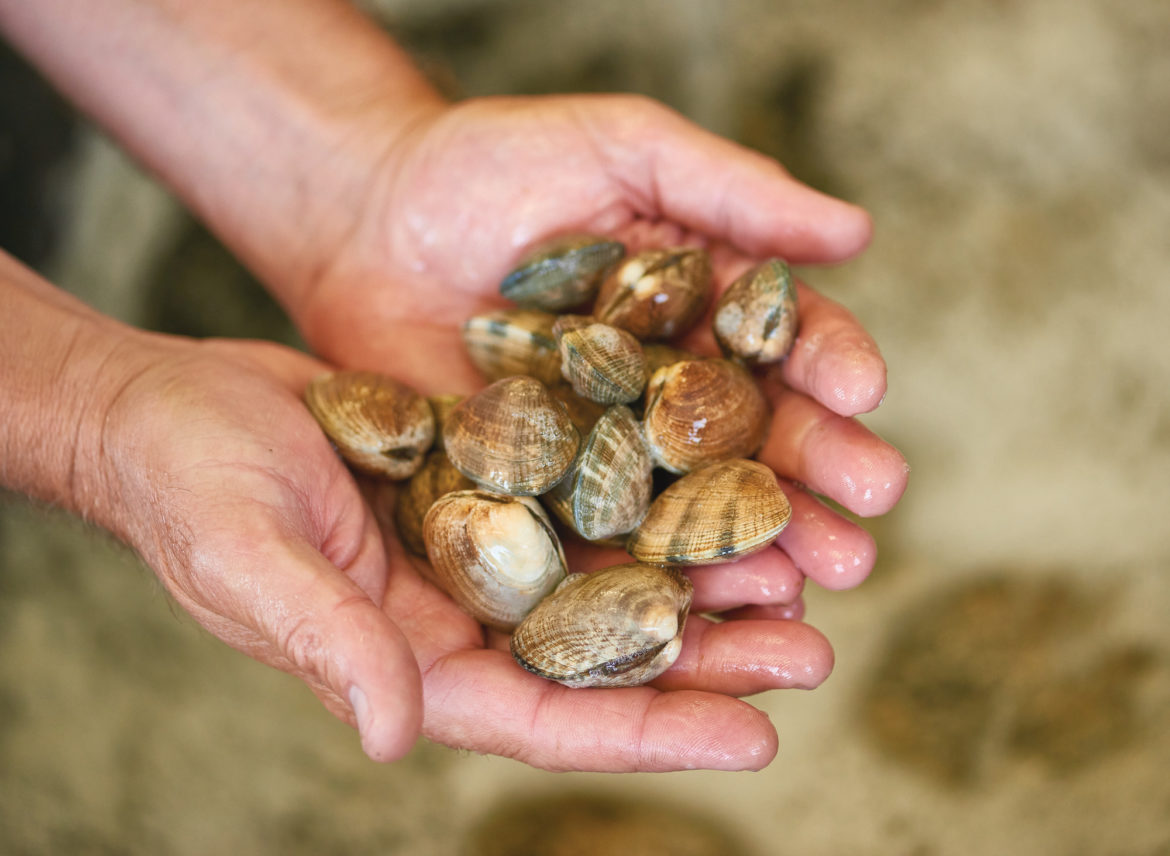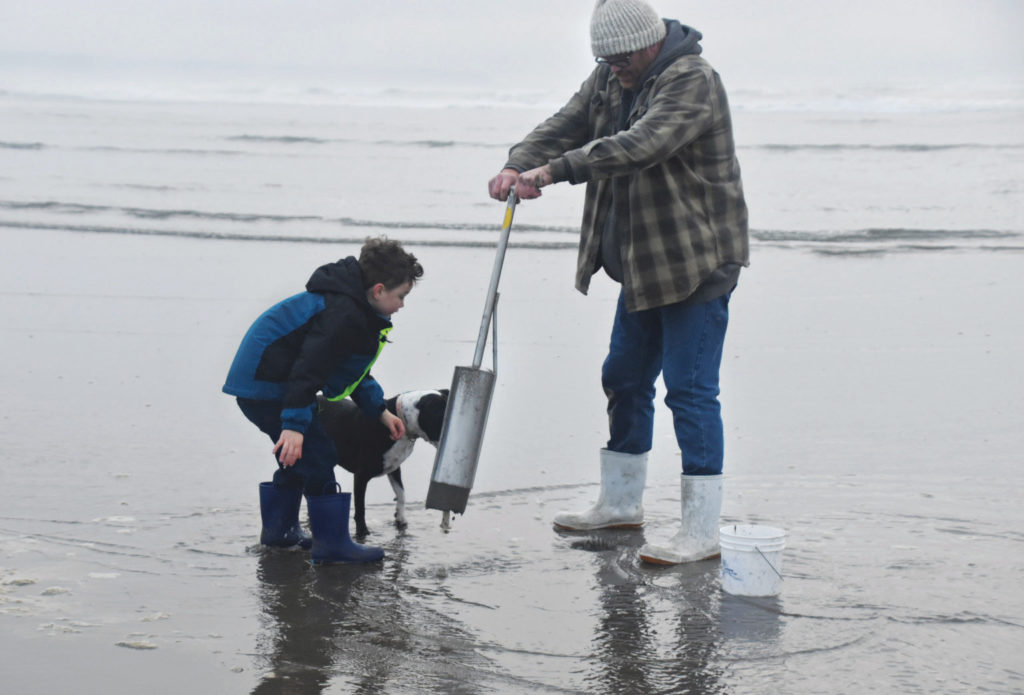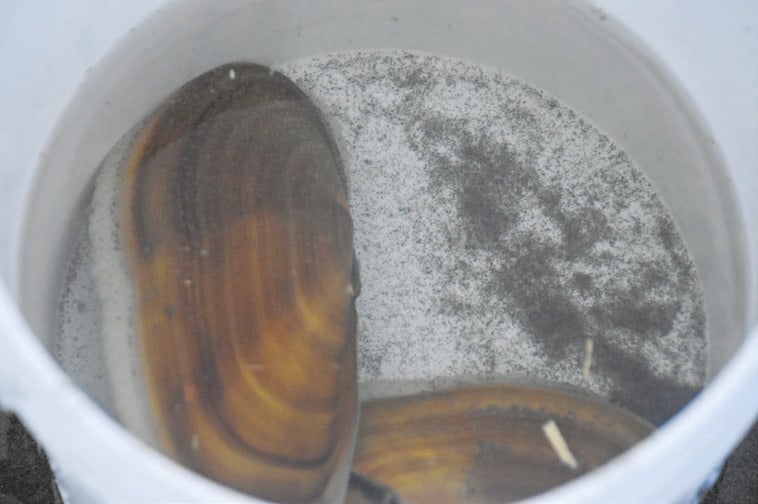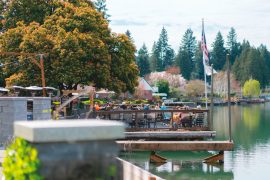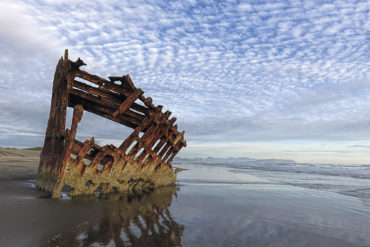Just below the surface, the Oregon Coast is teeming with various clam types
written by Julie Lee
Don’t mind getting a little sandy, muddy and wet? Clamming might be for you! Anyone can dig for clams, and little equipment is needed: a clam shovel, a clam gun, a bucket and some patience.
A shellfish license is required as well.
The best clamming on the Oregon Coast is done during low tides, and it’s recommended to check with Oregon Health Authority’s website to ensure clam harvesting is open; they follow strict guidelines and constantly survey for potential biotoxins.
Razor clams are a foodie’s delight and prized by clam diggers for their size and sweet-tasting meat. Clatsop County is bountiful with this seafood delicacy, with 95 percent of all razor clams deriving from a tight eighteen-mile stretch of beach.
Bay clams, a broad grouping that encompasses everything that isn’t a razor clam, includes varieties such as butter, littleneck, cockles and gaper clams. Unlike razors, which are limited for clamming from October to mid-July to protect young clams in the summer months, bay clams are widely available and harvested throughout the summer.
Each variety of bay clams are unique: butter clams are commonly found in large estuarine systems such as Coos, Tillamook and Yaquina; cockles rest a little closer to sand’s surface and move horizontally, even jumping a foot or two at a time using their highly-developed foot; littlenecks are found in more rocky or gravelly areas; gaper clams are Oregon’s most common, well known to go into chowders the Oregon Coast is famous for.
An easier species to dig for, hovering just about six inches deep, are purple varnish clams and softshell clams, with limits about three times that of bay clams. Softshell clams are found in nearly all of Oregon’s estuaries and were originally native to the East Coast.
At the helm of the kitchen at Stephanie Inn, a luxury Cannon Beach hotel with a loyal following, executive chef Aaron Bedard steers the daily menu based on whatever can be fresh caught, harvested, foraged or dug for. A favorite is clams. On his days off, he digs for clams himself.
“We definitely roll with the seasons,” he said. “We source as close to home as possible for the restaurant. If it’s root vegetable season, that’s what we do. We feature what’s in our backyard at that point in time and with that comes some inspirational challenges, like what all can I do with turnips and kale?”
Clams are always in Bedard’s backyard. Bedard lives between Del Rey Beach and Sunset Beach, a razor clam entry point and enjoys taking his six-year-old son, Jacob, digging for clams. “I like to teach my son how to harvest right where we live,” said Bedard. “We’ll go crabbing on Netart Bay, digging for clams in Gearhart, and generally spend a lot of time outdoors, playing in the sand and mud rather than on the computer and video games.”
All species of clams have different limits, and razor clams have a 15-per-person cap. “I’m careful with what we take, making sure what we take gets used,” he said. “There is no need to take more than needed–save it for the future.”
Razor clam season was shut down last year for nearly sixteen months after tests continually came back detecting high levels of domoic acid, one of the many uncontrollable factors that Mother Nature can deliver. Bedard is grateful to have them available again, working them into the nightly menu whenever possible. He procures clams from smaller purveyors such as Ocean Beauty, which buys and sells direct from the docks, helping manage food safety protocols and ensuring inspections. He loves working with razor clams at the restaurant because they are indigenous and not farmed.
Bedard has been with the Stephanie Inn Dining Room for sixteen years, coming from Le Cordon Bleu College of Culinary Arts in Portland. He started as sous chef under first John New-man and then Crystal Corbin, who both went on to open other restaurants at Cannon Beach.
His path to being a chef was unplanned. He grew up the son of a Kentucky Fried Chicken franchise owner and helped in the restaurant, cooking from the time he was 14. When he graduated from high school, he wanted nothing to do with the industry and spent time in Texas before landing back in La Grande at Bench-warmer’s Pub & Grill, where he started doing scratch cookery and realized a philanthropic side of the restaurant industry, like sponsoring golf tournaments for the local high school.
At Stephanie Inn Dining Room, Bedard enjoys being part of people’s lives and special moments. The open kitchen format and boutique dining room setting allows for personal conversations with patrons, which Bedard relishes. “We get to talk to our customers every day and be part of their celebrations.”
What’s for dinner at the Bedard house? “We’re just regular people when it comes to food at home,” he said. “Dinner time is important to us. We cook every night together. Tonight we’ll have pan seared razor clams with fresh herbs and a rice pilaf.”
Try out some of chef Bedard’s delicious recipes: Razor clam beignets with a roasted red pepper romesco sauce and razor clam ceviche.
From Southpark Seafood in Portland comes a fairly simple yet delicious recipe: Manila clams with garlic confit.
Or for some Italian adventure, try linguine vongole with white sauce from the new Amore Restaurant at Spirit Mountain Casino in Grand Ronde.


